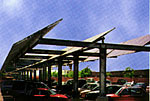 INNOVATIONS
INNOVATIONS 
Even with the technology we possess today it is important that we begin to integrate electric-powered vehicles as part of our daily lives.
We start by encouraging more households to begin taking part in this transformation by doing thing like maintaining an electric car for short range travel and a gasoline car for long-range travel. Higher gasoline taxes would also encourage the public to seek alternative means of transportation. In general, it is important that we take advantage of the present solar technology.
Already, many environmentally active people are finding ways to incorporate solar energy technology into their homes by doing things like placing solar panels on the roof. This energy is then use to cool or heat their homes. In the future, if large amounts of energy are collected, it could be used to power the entire house including the family's electric automobiles.Some of the most important applications of solar energy are nearly invisible. Telecommunications, oil companies, and highway safety equipment all rely on solar power for dependable, constant power, far from any power lines.
- Call Boxes: Look at any California roadside call box, and you'll see a solar panel. California standardized on the use of solar power and cellular phones to eliminate the need for any buried cable connections to these phones. Given the sometimes literally life-saving nature of these call boxes, dependability is a must.
- Roadside signs: Solar power is used for many lighted highway signs, eliminating the need for diesel generators.
Telecommunications installations: When you need a microwave repeater on a remote mountaintop, the last thing you want to do is run a power line up to it. For reliable power, many communications repeaters in remote areas use solar. (Innovations: A carport with photovoltaic cell panels: Solar powered cars are charged while they are parked in this futuristic garage.)
`
How practical is solar for home and mobile home/marine use?
These days, it's pretty practical, especially for remote homes. Until solar power came along, people who wanted to live in remote areas frequently had to pay large fees to have a power cable run to their house. Now, a remote home can be virtually self-sufficient with solar power. Even in areas where power lines are nearby, solar may be a viable alternative to being connected to a power company. An average home has more than enough roof area to produce enough solar electricrity to supply all of its power needs
The bottom line is that electric and solar technology will be an essential part of future low-emissions transportation that will be attractive to consumers and better for the environment. The extent or degree of impact will be defined and depend on technological advances of solar cells and batteries.
- If you would like to learn more about the SOLAR POWERED SATELLITES at NASA click here.
- Making of a NEW SOLAR CAR for a race.
- BACK TO OUR PROFESSOR'S, DR.NORMAN, PAGE
- Back to our title page